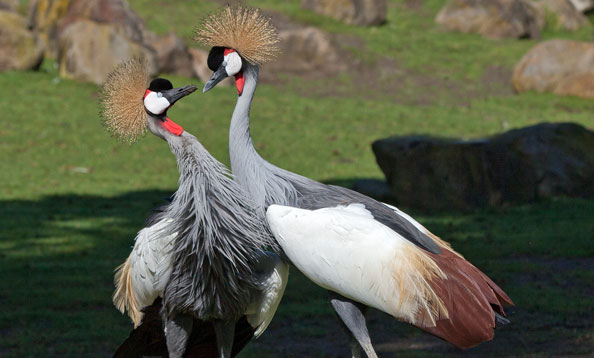East African Crowned Crane
Balearica regulorum

At the Zoo
Our crowned cranes roam in the Leanne B. Roberts African Savanna habitat.
Fascinating Facts
- East African crowned cranes are a subspecies of grey crowned cranes; South African crowned cranes are another subspecies.
- These birds are noted for their spectacular dances, which involve head-bobbing, wing fluttering, leaps and bows.
- Crowned cranes are the only crane species to perch in trees.
- They fly with the neck extended forward and legs stretched horizontally behind the tail.
Physical Characteristics
They are named for the striking, straw colored bristle-like feathers on the top of their heads. They are mostly slate gray with bold black and white wings and a black head. The legs and bill are black, eyes are light grey, facial skin is white and red, and throat fold is scarlet. These cranes have large white cheek with a small red patch at the top. The bill is proportionally shorter than in other cranes. They have long legs for wading through the grasses. The feet are large, yet slender, adapted for balance rather than defense or gasping. The cranes’ long legs and excellent peripheral vision help them spot predators in the tall savanna grasses.
Juvenile cranes are mostly brown with a darker crown and neck.
Lifespan is about 22 years in the wild, and up to 25 in captivity.
Habitat/Diet
They are found in marshes, cultivated lands and grasslands near rivers and lakes in eastern from the Uganda and Kenya, south to Zimbabwe and South Africa.
Like other cranes, they are omnivores, eating plants, seeds, grain, small fish, insects, amphibians, worms, small reptiles and the eggs of aquatic animals. Stamping their feet as they walk, they flush out insects which are quickly caught and eaten. The birds also associate with grazing herbivores; benefiting from the ability to grab prey items disturbed by antelopes and gazelles.
Social Behavior
They are social during most of the year, living in pairs or family parties and congregating in flocks of up to 200 birds. Crowned cranes are typically non-migratory but will sometimes travel long distances based on food and nesting site availability.
They emit a trumpeting call of “u-wang u-wang” and also a guttural grunt. Their loud, melodious call, usually given in flight, may have given rise to some of the beliefs held by local people that the cranes bring rain; many tribal groups have incorporated the cranes’ dances into their own rituals.
Both males and females participate in elaborate courtship rituals, and immature birds join the adults. Dancing is an integral part of breeding season behavior, but also may be done at any time of the year. Crowned cranes are monogamous and pair for life.
Breeding season usually occurs from December to February but varies throughout the range and sometimes occurs year-round. Pairs construct a large nest of grasses and vegetation on marshy edges and in low trees. Two to three glossy, bluish-white eggs are laid, and both parents take turns incubating them for about 30 days. Chicks are precocial, can run as soon as they hatch, and fly in 10 weeks.
Status In The Wild
East African crowned cranes are listed as endangered by the IUCN. They are threatened by habitat loss as swamps and marshes are drained or dammed for agriculture. Crowned crane eggs are collected and chicks are often victims of illegal trade as well.
What can you do to help crowned cranes?
- Support conservation efforts of organizations like the International Crane Foundation and AZA accredited zoos working to save these incredible birds.
- Spread the word about crowned crane conservation!
